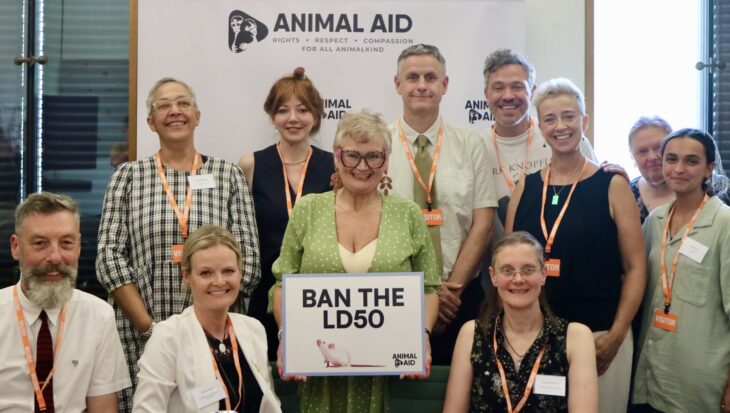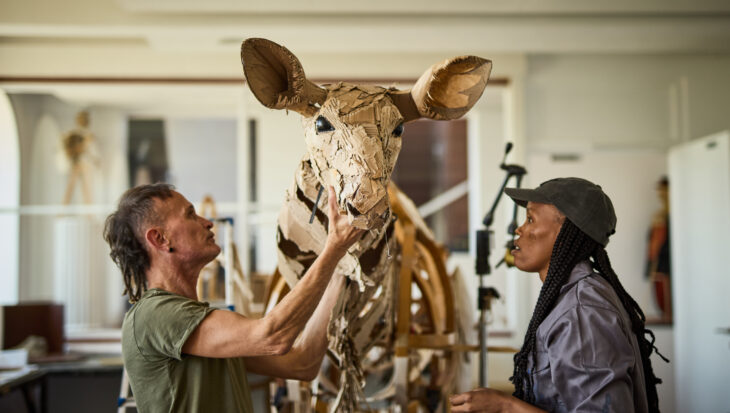Animal Aid in parliament to discuss ending animal tests
Yesterday, Animal Aid hosted a roundtable in Westminster, to meet with MPs and other invited guests to discuss the ending the LD50 and other animal tests.
Posted 02 Jul 2025

Posted on the 2nd February 2024
Animal Aid and some of our amazing supporters were out on the streets of Cambridge yesterday to highlight cruel experiments being conducted at Cambridge University.

According to the 2022 figures for the University of Cambridge, a total of 206,992 animals were used in laboratory experiments. 68 experiments involved the use of primates with 4 of these being classified as “severe.” The term “severe” is reserved for the highest level of pain, suffering, distress and lasting harm legally permissible to inflict on animals in experimental settings.
One experiment carried out at the university involved using marmosets (a type of small monkey), who had holes drilled in their skulls and a substance injected into their brains
The experiment aimed to study:
The 11 monkeys used in these experiments are described as being ‘bred on site at the University of Cambridge Marmoset Breeding Colony’. It is of great concern that, with a breeding colony of these small, sensitive and intelligent animals, the researchers will continue with research of this type. Indeed, they describe how they plan more ‘experiments to further reveal the pathway-specific dysregulation in non-human primates’.
The information from animal experiments often fails to translate to humans because there are significant physiological and genetic differences between the species. Marmosets are much smaller than humans, have different metabolic rates, immunological functions, and brain structures. For example, the marmoset brain is much smaller than the human brain, around 8 grams compared to around 1300 grams in humans. This affects brain complexity, cognition, and behaviour. Such interspecies differences mean that a substance showing efficacy in marmosets cannot be assumed to work the same way in humans.
Sadly, the use of primates is the tip of the iceberg for the University of Cambridge. Other animals harmed in experiments at the university included mice, sheep, rabbits, pigs, and chickens. Animal Aid launched the campaign ‘Universities Challenged’ last year, to increase transparency around animal experiments happening at British universities.
‘We believe it is time to challenge all universities' use of animals in experiments. In one experiment the University of Cambridge harmed and killed 11 monkeys in invasive, distressing and ultimately fatal experiments. We urge the public in Cambridge and beyond to question the animal experiments being conducted at their local university and to urge universities to invest in progressive, humane and relevant science and to move away from cruel animal experiments.’
Jessamy Korotoga, Head of Campaigns at Animal Aid
The researchers describe how the marmosets were housed in ‘male-female pairs’ in cages which were 2.8 x 1.2 x .98 m. This information shows how unnatural life in a laboratory is for these animals. They originally come from Brazil and in the wild they would live in groups of up to 20 individuals and have a home range of between one and 16 acres (an acre is about half the size of a typical football pitch)
In the wild the animals can live as they like, typically they would be more active in early morning and the later evening. Around midday, they will nap and groom a lot. At night the group would sleep together in a tangle of vines or on a tree branch.
Visit our ‘Universities Challenged’ website to find out moreYesterday, Animal Aid hosted a roundtable in Westminster, to meet with MPs and other invited guests to discuss the ending the LD50 and other animal tests.
Posted 02 Jul 2025

Have you heard? A breathtaking arts initiative, ‘The Herds’ will be arriving in London this Friday.
Posted 27 Jun 2025
